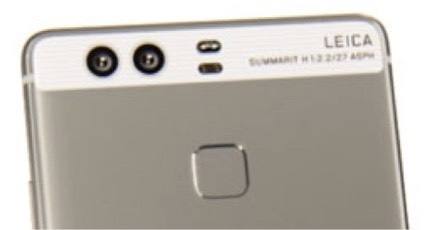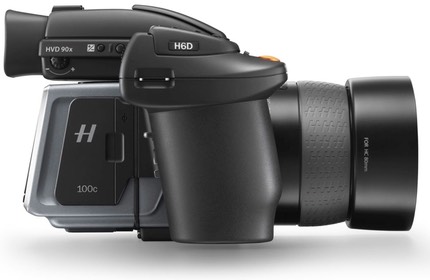No, this article isn’t what you’re probably expecting from the title. Read on. Updated
The world moves in mysterious ways.
Perusing the press releases and media information I received last week I was struck by two particular ones that essentially tell us something useful. The Huawei P9 and the Hasselblad H6D represent a near perfect bracketing of what it means to be a “camera" these days.
At the bottom of the photography market, we have smartphones, and as I’ve been noting for several years now, the next step for smartphone cameras is multiple sensors.

The Huawei P9 has two matched 12mp sensors and lenses co-developed with Leica. One of the sensors is Bayer (color), the other straight monochrome.
Huawei is using one of the six different multi-sensor ideas I’ve seen that look promising: the second sensor gives you post focus capabilities (depth map), plus the lack of filtration on the monochrome side means that more light gets to that sensor and its data can be used to inform noise reduction and acuity on the color sensor.
It’s still too early to know how well the P9 approach works, but I was generally impressed with the sample images they provided. Certainly another step upwards in terms of smartphone image quality.
But actually the thing that impressed me most was the Leica-designed software for the phone’s camera. It initially appears like most phone cameras: minimal interface. But a swipe up gives you the full set of camera and setting controls and you can pay attention to individual parameters. One of the better “full control” setups I’ve seen from a phone, and something that pairs well with better image quality, obviously.
So I’d say that the Huawei P9 is now at the bottom of the bracket of products for people who are interested enough in photography to greatly care about results and control how they got them.

At the other end of the spectrum we had Hasselblad pushing up their offerings to a new model that has 100mp, video, dual card slots, WiFi, faster tethering support, and a touchscreen for modern control.
The new H6D100C is about as many megapixels as you can attain, and about as modern in features as we’ve got (though I’d be remiss if I didn’t point out that the PhaseOne XF got there first). For practical on-the-go and studio photography, these cameras define about the top end of what any serious photographer is using these days.
So bookends. A pretty darned good 12mp 12-bit camera that fits in your pocket and produces images that would be the envy of compact cameras of only a few years ago, and a pretty darned good 100mp 16-bit camera that fits nicely into your studio and produces images about as good as we can get from commercial products. That’s the photographer-tools world we’re in today. Note that both cameras use touch controls and both communicate easily with the rest of the world. Both can create video.
The real question is this: where are the customers at? What bar do they really set for their image quality? Is it closer to the 12mp 8-bit one that can be instantly shared, or the 100mp 16-bit world that has a more traditional workflow?
Pretty obviously, we'll eventually have a billion folks or more at the lower end of that spectrum as smartphones update, and maybe tens of thousands at the other. How much room is there in the middle for Canikon and the Seven Dwarves? CIPA numbers suggest low tens of millions and declining. The problem is that trying to climb towards where Hasselblad and PhaseOne currently sit just nets you fewer customers at higher prices, and worse, many fewer customers than would make up for the higher prices you charged.
Now I’ve defined this as 12mp 8-bit versus 100mp 16-bit, but that’s a false analysis. It’s an easy way to describe things, but it’s not the real reason for the camera market decline. How could it be? After all, we’ve now got 24mp cameras at less than 12mp camera prices that were less than 6mp camera prices a few years ago.
No, the real thing to note in the bookends is the workflow. Swipe, swipe, tap, tap: image taken and shared. That’s the true lower end of the spectrum, versus plug camera into computer…oh dear, I don’t even want to go through all the steps before that image gets truly shared. Yes, Hasselblad tries to make it easier with a WiFi connection, but ultimately they want you to be running their Phocus software and using a more traditional camera-to-computer-to-client workflow.
Still, I have to point out that the workflow for Hasselblad and PhaseOne cameras in the studio is more refined than it is for Canon and Nikon cameras. See the problem?
Those of us who care about our images always want more pixels, more dynamic range, more speed, more bit depth, more everything. But what we’re actually missing is what is the real reason for the decline of all of those cameras in the middle of the current bookends: the workflow sucks.
More and more, getting what we need out of those cameras is a nerdy, technical, time-intensive, multi-step process, let alone actually sharing the result. Until that changes, camera sales will continue to tank.
Update: a previous version of this article mentioned that the Huawei was 8-bit. All current Android devices can create 12-bit DNG files, so I’ve changed the article to reflect that. However, do note that the actual bit depth the data is recorded in does not usually reflect the accuracy of the data. Many cameras record in deeper bit depths than their ADCs accurate produce. For instance, the just released Nikon D5 records in 14 bits, but the accuracy of the data is about 12 bits.





